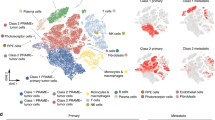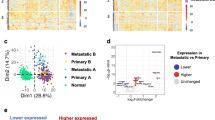Abstract
Although patients diagnosed with melanoma of ⩽1.00 mm thickness have a relatively good cure rate, the prognosis for patients with locally advanced and metastatic melanoma is grave. The discovery of new and effective therapies for this disease depends in large part on molecular studies that will resolve why advanced-stage melanoma is refractory to conventional chemotherapy and radiation therapy. To identify genes that have important functions in advanced-stage melanomas, in particular, in melanoma-infiltrated lymph nodes, which are not well characterized at the molecular level, we generated a LongSAGE library from a melanoma-positive lymph node, and subjected melanoma-infiltrated lymph nodes to protein expression profiling. The data document that the molecular signature of melanoma, which has spread to regional lymph nodes, is very similar to the molecular signature of primary melanomas. Equally important, we provide evidence that the ubiquitin-conjugating enzyme, Ubc9, is expressed at high levels in melanoma-positive lymph nodes, and that it plays a crucial role in preventing advanced-stage melanomas from undergoing chemotherapy-induced apoptosis.
This is a preview of subscription content, access via your institution
Access options
Subscribe to this journal
Receive 50 print issues and online access
$259.00 per year
only $5.18 per issue
Buy this article
- Purchase on Springer Link
- Instant access to full article PDF
Prices may be subject to local taxes which are calculated during checkout





Similar content being viewed by others
References
Balch CM, Buzaid AC, Atkins MB, Cascinelli N, Coit DG, Fleming ID et al. (2000). A New American Joint Committee on Cancer staging system for cutaneous melanoma. Cancer 88: 1484–1491.
Balch CM, Soong SJ, Atkins MB, Buzaid AC, Cascinelli N, Coit DG et al. (2004). An evidence-based staging system for cutaneous melanoma. CA Cancer J Clin 54: 131–149.
Becker D, Meier CB, Herlyn M . (1989). Proliferation of human malignant melanomas is inhibited by antisense oligodeoxynucleotides targeted against basic fibroblast growth factor. EMBO J 8: 3685–3691.
Bolstad BM, Irizarry RA, Astrand M, Speed TP . (2003). A comparison of normalization methods for high-density oligonucleotide array data based on bias and variance. Bioinformatics 19: 185–193.
Edwards D . (2003). Non-linear normalization and background correction in one-channel cDNA microarray studies. Bioinformatics 19: 825–833.
Hayashi T, Seki M, Maeda D, Wang W, Kawabe Y, Seki T et al. (2002). Ubc9 is essential for viability of higher eukaryotic cells. Exp Cell Res 280: 212–221.
Herlyn M . (2006). Molecular targets in melanoma: strategies and challenges for diagnosis and therapy. Int J Cancer 118: 523–526.
Herlyn M, Rodeck U, Mancianti M, Cardillo FM, Lang A, Ross AH et al. (1987). Expression of melanoma-associated antigens in rapidly dividing human melanocytes in culture. Cancer Res 47: 3057–3061.
Hoege C, Pfander B, Moldovan GL, Pyrowolakis G, Jentsch S . (2002). RAD6-dependent DNA repair is linked to modification of PCNA by ubiquitin and SUMO. Nature 419: 135–141.
Johnson ES, Blobel G . (1997). Ubc9p is the conjugating enzyme for the ubiquitin-like protein Smt3p. J Biol Chem 272: 26799–26802.
Kovalenko OV, Plug AW, Haaf T, Gonda DK, Ashley T, Ward DC et al. (1996). Mammalian ubiquitin-conjugating enzyme Ubc9 interacts with Rad51 recombination protein and localizes in synaptonemal complexes. Proc Natl Acad Sci USA 93: 2958–2963.
Lin X, Liang M, Liang YY, Brunicardi FC, Feng XH . (2003). SUMO-1/Ubc9 promotes nuclear accumulation and metabolic stability of tumor suppressor Smad4. J Biol Chem 278: 31043–31048.
Lin JY, Ohshima T, Shimotohno K . (2004). Association of Ubc9, an E2 ligase for SUMO conjugation, with p53 is regulated by phosphorylation of p53. FEBS Lett 573: 15–18.
McDonald SL, Edington HD, Kirkwood JM, Becker D . (2004). Expression analysis of genes identified by molecular profiling of VGP melanomas and MGP melanoma-positive lymph nodes. Cancer Biol Ther 3: 121–123.
Mo YY, Yu Y, Ee PL, Beck WT . (2004). Overexpression of a dominant-negative mutant Ubc9 is associated with increased sensitivity to anticancer drugs. Cancer Res 64: 2793–2798.
Mo YY, Yu Y, Theodosiou E, Rachel Ee PL, Beck WT . (2005). A role for Ubc9 in tumorigenesis. Oncogene 24: 2677–2683.
Nacerddine K, Lehembre F, Bhaumik M, Artus J, Cohen-Tannoudji M, Babinet C et al. (2005). The SUMO pathway is essential for nuclear integrity and chromosome segregation in mice. Dev Cell 9: 769–779.
Perlis C, Herlyn M . (2004). Recent advances in melanoma biology. Oncologist 9: 182–187.
Premont RT, Claing A, Vitale N, Freeman JL, Pitcher JA, Patton WA et al. (1998). β2-adrenergic receptor regulation by GIT1, a G protein-coupled receptor kinase-associated ADP ribosylation factor GTPase-activating protein. Proc Natl Acad Sci USA 95: 14082–14087.
Rizos H, Woodruff S, Kefford RF . (2005). p14ARF interacts with the SUMO-conjugating enzyme Ubc9 and promotes the sumoylation of its binding partners. Cell Cycle 4: 597–603.
Rodriguez MS, Desterro JM, Lain S, Midgley CA, Lane DP, Hay RT . (1999). SUMO-1 modification activates the transcriptional response of p53. EMBO J 18: 6455–6461.
Saha S, Sparks AB, Rago C, Akmaev V, Wang CJ, Vogelstein B et al. (2002). Using the transcriptome to annotate the genome. Nat Biotechnol 20: 508–512.
Seufert W, Futcher B, Jentsch S . (1995). Role of a ubiquitin-conjugating enzyme in degradation of S- and M-phase cyclins. Nature 373: 78–81.
Smith AP, Hoek K, Becker D . (2005). Whole-genome expression profiling of the melanoma progression pathway reveals marked molecular differences between nevi/melanoma in situ and advanced-stage melanomas. Cancer Biol Ther 4: 1018–1029.
Smith AP, Weeraratna AT, Spears JR, Meltzer PS, Becker D . (2004). SAGE identification and fluorescence imaging analysis of genes and transcripts in melanomas and precursor lesions. Cancer Biol Ther 3: 104–109.
Tago K, Chiocca S, Sherr CJ . (2005). Sumoylation induced by the Arf tumor suppressor: a p53-independent function. Proc Natl Acad Sci USA 102: 7689–7694.
Tashiro K, Pando MP, Kanegae Y, Wamsley PM, Inoue S, Verma IM . (1997). Direct involvement of the ubiquitin-conjugating enzyme Ubc9/Hus5 in the degradation of IkappaB alpha. Proc Natl Acad Sci USA 94: 7862–7867.
Tsao H, Atkins MB, Sober AJ . (2004). Management of cutaneous melanoma. N Engl J Med 351: 998–1012.
Ungureanu D, Vanhatupa S, Kotaja N, Yang J, Aittomaki S, Janne OA et al. (2003). PIAS proteins promote SUMO-1 conjugation to STAT1. Blood 102: 3311–3313.
Valesky M, Spang AJ, Fisher GW, Farkas DL, Becker D . (2002). Noninvasive dynamic fluorescence imaging of human melanomas reveals that targeted inhibition of bFGF or FGFR-1 in melanoma cells blocks tumor growth by apoptosis. Mol Med 8: 103–112.
Velculescu VE, Zhang L, Vogelstein B, Kinzler KW . (1995). Serial analysis of gene expression. Science 270: 484–487.
Wang Y, Becker D . (1997). Antisense targeting of basic fibroblast growth factor and fibroblast growth factor receptor-1 in human melanomas blocks intratumoral angiogenesis and tumor growth. Nat Med 3: 887–893.
Wang E, Panelli MC, Zavaglia K, Mandruzzato S, Hu N, Taylor PR et al. (2004). Melanoma-restricted genes. J Transl Med 15: 34.
Wang ZY, Qiu QQ, Seufert W, Taguchi T, Testa JR, Whitmore SA et al. (1996a). Molecular cloning of the cDNA and chromosome localization of the gene for human ubiquitin-conjugating enzyme 9. J Biol Chem 271: 24811–24816.
Wang Y, Rao U, Mascari R, Richards TJ, Panson AJ, Edington HD et al. (1996b). Molecular analysis of melanoma precursor lesions. Cell Growth Differ 7: 1733–1740.
Watanabe TK, Fujiwara T, Kawai A, Shimizu F, Takami S, Hirano H et al. (1996). Cloning, expression, and mapping of UBE2I, a novel gene encoding a human homologue of yeast ubiquitin-conjugating enzymes, which are critical for regulating the cell cycle. Cytogenet Cell Genet 72: 86–89.
Weeraratna AT, Becker D, Carr KM, Duray PH, Rosenblatt KP, Yang S et al. (2004). Generation and analysis of melanoma SAGE libraries: SAGE advice on the melanoma transcriptome. Oncogene 23: 2264–2274.
Xu W, Gong L, Haddad MM, Bischof O, Campisi J, Yeh ET et al. (2000). Regulation of microphthalmia-associated transcription factor MITF protein levels by association with the ubiquitin-conjugating enzyme hUBC9. Exp Cell Res 255: 135–143.
Yasugi T, Howley PM . (1996). Identification of the structural and functional human homolog of the yeast ubiquitin conjugating enzyme UBC9. Nucleic Acids Res 24: 2005–2010.
Acknowledgements
We thank Marie Acquafondata for Ubc9 antibody staining of the TMAs. This work was supported by grants from the National Institutes of Health (DB), and the Robert Johnson Foundation (SJM). The authors declare that they have no competing financial interests.
Author information
Authors and Affiliations
Corresponding author
Rights and permissions
About this article
Cite this article
Moschos, S., Smith, A., Mandic, M. et al. SAGE and antibody array analysis of melanoma-infiltrated lymph nodes: identification of Ubc9 as an important molecule in advanced-stage melanomas. Oncogene 26, 4216–4225 (2007). https://doi.org/10.1038/sj.onc.1210216
Received:
Revised:
Accepted:
Published:
Issue Date:
DOI: https://doi.org/10.1038/sj.onc.1210216
Keywords
This article is cited by
-
The SUMOylation and ubiquitination crosstalk in cancer
Journal of Cancer Research and Clinical Oncology (2023)
-
LncRNA PVT-1 promotes osteosarcoma cancer stem-like properties through direct interaction with TRIM28 and TSC2 ubiquitination
Oncogene (2022)
-
An in vitro Förster resonance energy transfer-based high-throughput screening assay identifies inhibitors of SUMOylation E2 Ubc9
Acta Pharmacologica Sinica (2020)
-
SUMO and the robustness of cancer
Nature Reviews Cancer (2017)
-
Function and clinical significance of SUMOylation in type I endometrial carcinoma
Oncology and Translational Medicine (2017)



